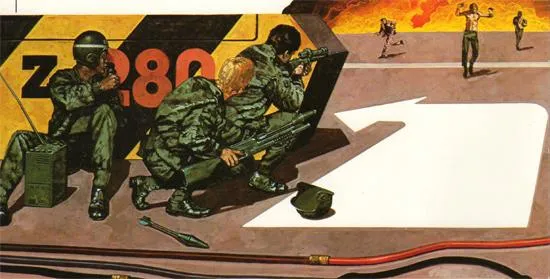Fighting Terrorism in the Future
A 1981 book predicted that the soldiers of the future could be more like heavily armed policemen than a fighting force
/https://tf-cmsv2-smithsonianmag-media.s3.amazonaws.com/filer/201203211220401981-soldier-of-the-future-470x251.jpg)
The 1981 book World of Tomorrow: Future War and Weapons by Neil Ardley is (naturally) a little dark for juvenile literature. Space pirates slaughter families while they picnic on space colonies, armies poison each other to create vivid hallucinations, and people on Earth live in underground shelters after a horrifying nuclear war destroys life as we know it.
Most of the book hasn’t yet come to pass in its bleak depiction of a world engulfed by hyper-futuristic weaponry and mayhem. But one two-page spread sticks out as a prescient vision of our world today. Ardley’s description of the soldier of the future forecasts technologies that currently exist or are under development: GPS guided weapons, helmets with eye-tracking sensors and flame-resistant uniforms that can protect against 2nd or 3rd-degree burns:
In several ways the soldier of the future will resemble the soldier of the distant past. He or she will be heavily protected — not encased in a suit of iron but clothed in ultrastrong materials that will resist rifle fire and radiation. The soldier may look out through a mask that cleans the air of radioactive dust, chemical poisons or disease germs used by the enemy. To attack, the soldier could use a future version of the crossbow — a small portable missile launcher. However, the solider will not have to aim the weapon. Using a computer, the position of the target can be fed into the missile’s guidance system and it will streak home. If the target moves, the missile will pursue it automatically, or the soldier may “see” or even “think” it home using a guidance computer linked to the soldier’s own eyes or brain!
The book is obviously rooted in the concerns of the time. One concern was terrorism, especially as it related to aircraft hijackings. Hijackings were at their peak between 1968 and 1972, when there were 137 attempted commercial aircraft hijackings in the United States.
The illustration below shows soldiers of the future dealing with terrorists who have taken over an airport. Terrorists and hostages alike flee from the burning wreckage of a commercial plane.

The book doesn’t rule out the possibility of nuclear weapons being used in the future, while mentioning that domestic terrorism may be just as large a threat in the years to come.
A future nuclear conflict or one using neutron weapons or energy beams would destroy human forces. There would be little that soldiers could do to help win such a war. It seems likely that the future role of the soldier will not always be to fight foreign enemies but often terrorists within a nation. The soldiers of the future could be more like heavily armed policemen than a fighting force.
/https://tf-cmsv2-smithsonianmag-media.s3.amazonaws.com/accounts/headshot/matt-novak-240.jpg)
/https://tf-cmsv2-smithsonianmag-media.s3.amazonaws.com/accounts/headshot/matt-novak-240.jpg)